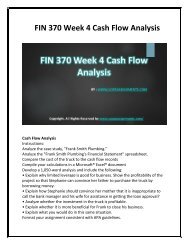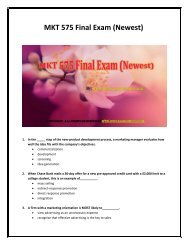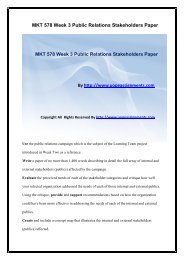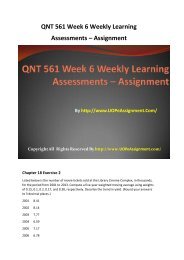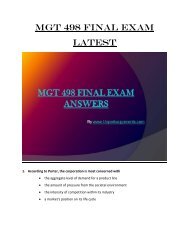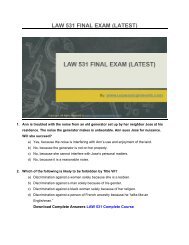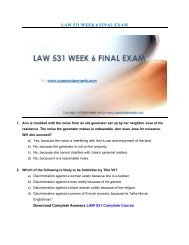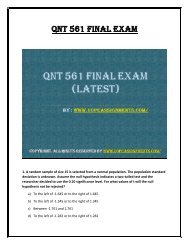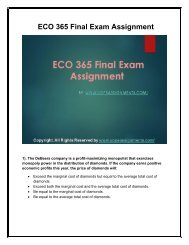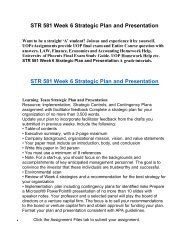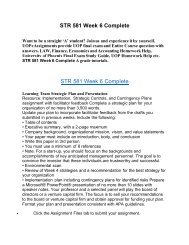FIN 571 Week 3 Connect Problems - Assignment
Work Smart and save time with FIN 571 Week 3 Connect Problems and experience the excellence.
Work Smart and save time with FIN 571 Week 3 Connect Problems and experience the excellence.
- No tags were found...
Create successful ePaper yourself
Turn your PDF publications into a flip-book with our unique Google optimized e-Paper software.
<strong>FIN</strong> <strong>571</strong> <strong>Week</strong> 3 <strong>Connect</strong><br />
<strong>Problems</strong> – <strong>Assignment</strong><br />
1. If the Hunter Corp. has an ROE of 13 and a payout ratio of 30 percent, what is its sustainable<br />
growth rate? (Do not round intermediate calculations and enter your answer as a percent<br />
rounded to 2 decimal places, e.g., 32.16.)<br />
Sustainable growth rate ____%<br />
2. The most recent financial statements for Williamson, Inc., are shown here (assuming no income<br />
taxes):<br />
Income Statement<br />
Balance Sheet<br />
Sales $ 6,700 Assets $22,050 Debt $ 8,050<br />
Costs 3,850 Equity 14,000<br />
Net income $ 2,850 Total $22,050 Total $22,050
Assets and costs are proportional to sales. Debt and equity are not. No dividends are paid. Next<br />
year’s sales are projected to be $7,906.<br />
What is the external financing needed? (Do not round intermediate calculations and round your<br />
answer to the nearest whole number, e.g., 32.)<br />
External financing needed $_____<br />
3. Projected future financial statements are called:<br />
plug statements.<br />
pro forma statements.<br />
reconciled statements.<br />
aggregated statements.<br />
comparative statements.<br />
4. One of the primary weaknesses of many financial planning models is that they:<br />
rely too much on financial relationships and too little on accounting relationships.<br />
are iterative in nature.<br />
ignore the goals and objectives of senior management.<br />
ignore cash payouts to stockholders.<br />
ignore the size, risk, and timing of cash flows.<br />
5. The maximum rate at which a firm can grow while maintaining a constant debt-equity ratio is best<br />
defined by its:<br />
<br />
<br />
<br />
<br />
<br />
rate of return on assets.<br />
internal rate of growth.<br />
average historical rate of growth.<br />
rate of return on equity.<br />
sustainable rate of growth.<br />
Find The Complete Answers just a click away <strong>FIN</strong> <strong>571</strong> <strong>Week</strong> 3 <strong>Connect</strong> <strong>Problems</strong> - <strong>Assignment</strong><br />
6. The external funds needed (EFN) equation projects the addition to retained earnings as:<br />
PM × ? Sales.<br />
PM ×? Sales × (1 - d).<br />
PM × Projected sales × (1 - d).<br />
Projected sales × (1 - d).<br />
PM ×Projected sales.<br />
7. Financial planning, when properly executed:<br />
<br />
ignores the normal restraints encountered by a firm.
is based on the internal rate of growth.<br />
reduces the necessity of daily management oversight of the business operations.<br />
ensures internal consistency among the firm?s various goals.<br />
eliminates the need to plan more than one year in advance.<br />
8. The return on equity can be calculated as:<br />
<br />
<br />
<br />
<br />
<br />
ROA × Equity multiplier.<br />
Profit margin × ROA.<br />
Profit margin × ROA × Total asset turnover.<br />
ROA ×(Net income / Total assets).<br />
ROA × Debt-equity ratio.<br />
9. In the financial planning model, the external financing needed (EFN) as shown on a pro forma<br />
balance sheet is equal to the changes in assets:<br />
<br />
<br />
<br />
<br />
<br />
plus the changes in liabilities minus the changes in equity.<br />
minus the changes in both liabilities and equity.<br />
minus the changes in liabilities.<br />
plus the changes in both liabilities and equity.<br />
minus the change in retained earnings.<br />
10. The extended version of the percentage of sales method:<br />
<br />
<br />
assumes that all net income will be paid out in dividends to stockholders.<br />
assumes that all net income will be retained by the firm and offset by a reduction in debt.<br />
is based on a capital intensity ratio of 1.0.<br />
<br />
requires that all financial statement accounts change at the same rate.<br />
separates accounts that vary with sales from those that do not vary with sales.<br />
Click here to download now – <strong>FIN</strong> <strong>571</strong> WEEK 3 QUIZ<br />
11. The sustainable growth rate will be equivalent to the internal growth rate when, and only when,:<br />
<br />
<br />
a firm has no debt.<br />
the growth rate is positive.<br />
the plowback ratio is positive but less than 1.<br />
a firm has a debt-equity ratio equal to 1.<br />
the retention ratio is equal to 1.<br />
12. Which one of the following depicts a correct relationship?<br />
<br />
<br />
<br />
<br />
<br />
Dividend payout ratio = 1 – Retention ratio<br />
Total asset turnover = 1 + Capital intensity ratio<br />
ROA = ROE × (1 + Debt-equity ratio)<br />
ROE = 1 – ROA<br />
Equity multiplier = 1 – Debt-equity ratio
13. All of the following can provide credit information about a customer except:<br />
the customer’s financial statements.<br />
credit reports.<br />
the customer’s current payment history with the seller.<br />
the amount of goods the customer desires to purchase.<br />
banks.<br />
14. The cash cycle is defined as the time between:<br />
the arrival of inventory and cash collected from receivables.<br />
selling a product and paying the supplier of that product.<br />
selling a product and collecting the accounts receivable.<br />
cash disbursements and cash collection for an item.<br />
the sale of inventory and cash collection.<br />
15. The minimum level of inventory that a firm wants to keep on hand at all times is referred to as:<br />
the base level.<br />
safety stock.<br />
the opportunity cost.<br />
the reorder point.<br />
keiretsu.<br />
Find the week 3 connect problems answers here – <strong>FIN</strong> <strong>571</strong> <strong>Week</strong> 3 <strong>Connect</strong> <strong>Problems</strong><br />
16. Given a fixed level of sales and a constant profit margin, an increase in the accounts payable<br />
period can result from:<br />
<br />
<br />
<br />
<br />
<br />
an increase in the cost of goods sold account value.<br />
an increase in the ending accounts payable balance.<br />
an increase in the cash cycle.<br />
a decrease in the operating cycle.<br />
a decrease in the average accounts payable balance.<br />
17. Selling goods and services on credit is:<br />
an investment in a customer.<br />
never necessary unless customers cannot pay for the goods.<br />
a decision independent of customers.<br />
permissible only if your bank lends the money.<br />
never a wise decision.<br />
18. On September 1, a firm grants credit with terms of 2/10 net 30. The creditor:<br />
must pay a penalty of 2/10 of one percent when payment is made later than October 1.
must pay a penalty of 10 percent when payment is made later than 2 days after October 1.<br />
receives a discount of 2 percent when payment is made at least 10 days prior to October 1.<br />
receives a discount of 2 percent when payment is made on September 1and pays a penalty of 10<br />
percent if payment is made after October 1.<br />
<br />
receives a discount of 2 percent when payment is made within 10 days.<br />
19. The three components of credit policy are:<br />
collection policy, credit analysis, and interest rate determination.<br />
collection policy, credit analysis, and terms of the sale.<br />
collection policy, interest rate determination, and repayment analysis.<br />
credit analysis, repayment analysis, and terms of the sale.<br />
interest rate determination, repayment analysis and terms of sale.<br />
20. The operating cycle can be decreased by:<br />
paying accounts payable faster.<br />
discontinuing the discount given for early payment of an accounts receivable.<br />
decreasing the inventory turnover rate.<br />
collecting accounts receivable faster.<br />
increasing the accounts payable turnover rate.<br />
Click here to download - <strong>FIN</strong> <strong>571</strong> Final Exam (Newest)<br />
21. The credit period begins on the:<br />
shipping date.<br />
purchase order date.<br />
shipping arrival date.<br />
order process date.<br />
invoice date.<br />
22. Since the credit decision usually includes riskier customers, the decision should adjust for this by:<br />
determining the probability that customers will not pay and reducing the expected cash flow.<br />
discounting the net cash flows at a lower discount rate.<br />
discounting the cash inflows at a higher discount rate.<br />
increasing the variable cost per unit.<br />
decreasing the variable cost per unit.<br />
23. A firm has an inventory turnover rate of 15.7, a receivables turnover rate of 20.2, and a payables<br />
turnover rate of 14.6. How long is the cash cycle?<br />
rev: 05_12_2016_QC_CS-51572<br />
28.46 days<br />
<br />
16.32 days
32.87 days<br />
13.08 days<br />
23.37 days<br />
24. Brown’s Market currently has an operating cycle of 76.8 days. It is planning some operational<br />
changes that are expected to decrease the accounts receivable period by 2.8 days and decrease<br />
the inventory period by 3.1 days. The accounts payable turnover rate is expected to increase from<br />
9 to 11.5 times per year. If all of these changes are adopted, what will be the firm's new operating<br />
cycle?<br />
<br />
<br />
<br />
<br />
<br />
68.4 days<br />
73.4 days<br />
63.3 days<br />
57.9 days<br />
70.9 days<br />
25. Jordan and Sons has an inventory period of 48.6 days, an accounts payable period of 36.2 days,<br />
and an accounts receivable period of 29.3 days. Management is considering offering a 5 percent<br />
discount if its credit customers pay for their purchases within 10 days. This discount is expected to<br />
reduce the receivables period by 17 days. If the discount is offered, the operating cycle will<br />
decrease from ___ days to ___ days.<br />
28.3; 11.3<br />
77.9; 60.9<br />
28.3; 45.3<br />
77.9; 94.9<br />
54.2; 37.2<br />
Want help? Click to download - <strong>FIN</strong> <strong>571</strong> <strong>Week</strong> 3 <strong>Connect</strong> <strong>Problems</strong> - <strong>Assignment</strong><br />
26. On average, D & M sells its inventory in 37 days, collects on its receivables in 3.4 days, and takes<br />
35 days to pay for its purchases. What is the length of the firm’s operating cycle?<br />
<br />
<br />
<br />
<br />
<br />
–1.4 days<br />
5.4 days<br />
33.6 days<br />
40.4 days<br />
41.6 days
About Author<br />
This article covers the topic for the University Of Phoenix <strong>FIN</strong> <strong>571</strong> <strong>Week</strong> 3 <strong>Connect</strong> <strong>Problems</strong> -<br />
<strong>Assignment</strong> The author is working in the field of education from last 5 years. This article covers<br />
the basic of <strong>FIN</strong> <strong>571</strong> <strong>Week</strong> 3 <strong>Connect</strong> <strong>Problems</strong> - <strong>Assignment</strong> from UOP. Other topics in the<br />
class are as follows :<br />
<strong>FIN</strong> <strong>571</strong> <strong>Week</strong> 1 Quiz<br />
<strong>FIN</strong> <strong>571</strong> <strong>Week</strong> 2 Quiz<br />
<strong>FIN</strong> <strong>571</strong> <strong>Week</strong> 3 Quiz<br />
<strong>FIN</strong> <strong>571</strong> <strong>Week</strong> 4 Quiz<br />
<strong>FIN</strong> <strong>571</strong> <strong>Week</strong> 5 Quiz<br />
<strong>FIN</strong> <strong>571</strong> <strong>Week</strong> 6 Quiz<br />
<strong>FIN</strong> <strong>571</strong> Final Exam (Newest)<br />
<strong>FIN</strong> <strong>571</strong> <strong>Week</strong> 1 <strong>Connect</strong> <strong>Problems</strong><br />
<strong>FIN</strong> <strong>571</strong> <strong>Week</strong> 2 <strong>Connect</strong> <strong>Problems</strong><br />
<strong>FIN</strong> <strong>571</strong> <strong>Week</strong> 3 <strong>Connect</strong> <strong>Problems</strong><br />
<strong>FIN</strong> <strong>571</strong> <strong>Week</strong> 4 <strong>Connect</strong> <strong>Problems</strong><br />
<strong>FIN</strong> <strong>571</strong> <strong>Week</strong> 5 <strong>Connect</strong> <strong>Problems</strong><br />
Want to check other classes..?? Visit http://www.uopeassignments.com/



